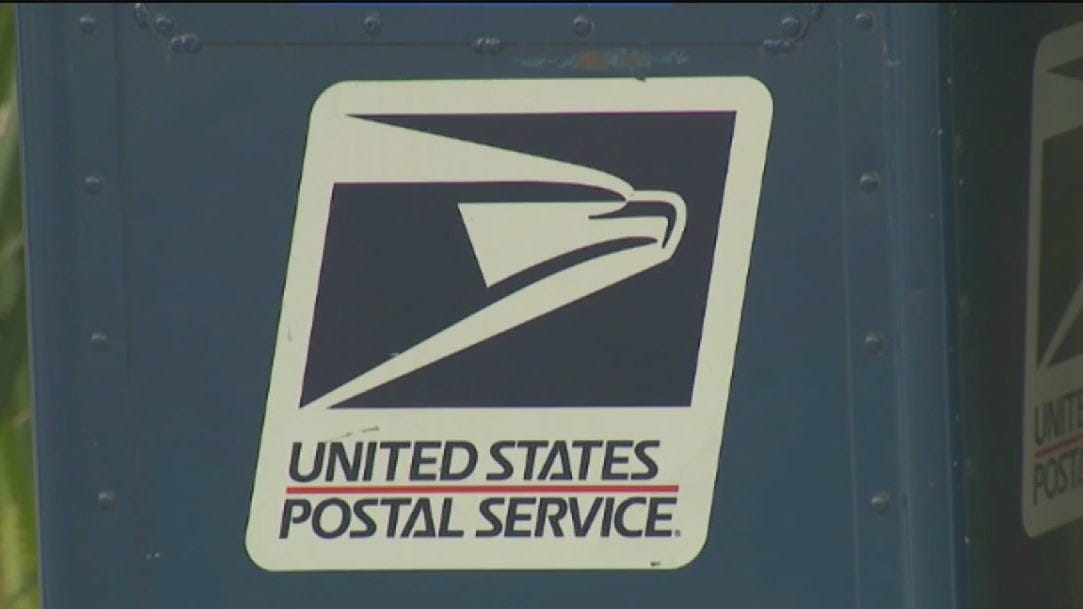As Trump pushes for changes, U.S. Postal Service struggles to deliver the mail on time
Delivery time for first-class mail has slipped, even with lower standards, report finds.

The U.S. Postal Service continues struggling to deliver mail on time, with delivery times for first-class letters slipping by 5% over the past two years, according to a new internal review.
The report by the USPS Inspector General found that delivery times are slowing even though the service has repeatedly given itself more time to deliver that mail. The postal service has struggled for years to meet its goals, in part because its leaders have said Congress micromanages how the it operates.
But in a time when Amazon customers can track their packages second-by-second, the inspector general warned that continued mail delays may prompt postal customers to seek alternatives, further exacerbating the financial challenges. The IG report also noted that the postal service needs to do a better job stopping its bulk-mailing clients from sending too-thick mailers that clog up automated sorting machines.
The postal service in 2021 launched a 10-year transformation dubbed "Delivering for America" aimed at cutting costs and giving more attention to package delivery, which can be more profitable.
"...it appears the Postal Service’s network will be in a transitional state for an undetermined number of years," the IG report concluded. "Despite massive network changes aimed at cutting costs and improving service, along with various price increases to support DFA, service levels remain inconsistent and financial stability has not yet been achieved."
President Donald Trump has floated making significant changes to how the postal service operates, and officials have called in Elon Musk's DOGE team to help stem financial losses that hit $9.5 billion last year.
Union representatives and other postal service boosters say Congress has put the service in an impossible position, and that making money shouldn't be the goal.
The postal service has a current goal of delivering first-class mail on time 88% of the time, significantly lower than its goal of 92.5% in 2023. Part of the challenge, the inspector general reported, is that the postal service is delivering 80% fewer pieces like personal letters or bills today compared to the late 1990s, but hasn't adequately adjusted its delivery system.
The IG report also noted the postal service struggles with misprocessing mail, in one case finding that a test package sent from Anaheim, California, to Denver inexplicably first detoured to two processing sites in Florida, delaying delivery by three days. In another case, a package sent from Tucson to Denver detoured through Wyoming and Utah ‒ after first arriving Denver ‒ delaying delivery by five days.
Priority mail deliveries have also slipped, although that data was kept confidential because the Postal Service competes with FedEx and UPS, among others, on that kind of delivery.
Trump has suggested merging the independent postal service with the Department of Commerce, which would require Congressional approval. Former Postmaster General Louis Dejoy stepped down earlier this year, and is being replaced by FedEx board member and former Waste Management CEO David Steiner. Steiner is currently undergoing mandatory background checks and is expected to formally assume the post in July.
Dejoy brought in Elon Musk's DOGE team to help the service cut costs and improve efficiency as it delivers mail to 165 million addresses six times a week. That move drew nationwide protests in support of the American Postal Workers Union, which has noted public sentiment overwhelmingly opposes significant cuts.
Last year, the service handled more than 116 billion pieces of mail, with most of that being presorted mailers, solicitations or other items that many people would consider "junk" mail. Overall mail volumes have been dropping since 2006, according to the postal service, but each year there are more and more addresses to deliver to.
Private companies like FedEx and UPS are outcompeting the postal service for some parcel deliveries, in part because it's a lot easier for them to charge higher prices for harder deliveries in rural area ‒ or to simply not deliver. Some of the changes underway at the postal service aim to better position it to compete for those deliveries, where profits can be higher.
Congress mandates that the postal service deliver affordably priced first-class mail to virtually every address in the country, regardless of how much it costs to do so. That's why it still uses mules or horses to deliver to Supai, Arizona, a remote Havasupai tribal village in the Grand Canyon of Arizona, or float planes to serve fishing villages off the Alaska coast.
Longtime postal service critic and now-retired New York University Prof. Steve Hutkins said the inspector general report makes it clear the service has a tough job ahead.
"The idea has been that at least they'd be able to achieve their targets with the lower standards, but the IG is suggesting things aren't going to get better for a long time," he said.
The postal service declined to answer questions from Paste BN about the report, instead referring to written comments it made to the inspector general.
"While service is not where it needs to be today, the changes are necessary to ensure the long-term operational improvements and financial condition improvements of the USPS well into the future," postal service managers wrote in response to the IG's report.